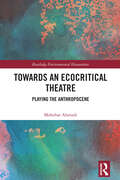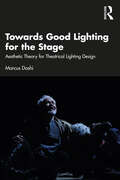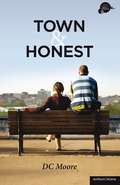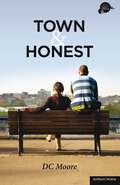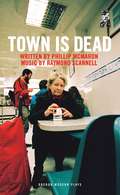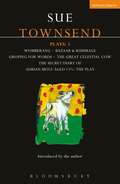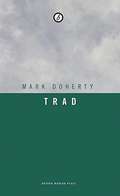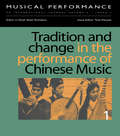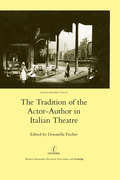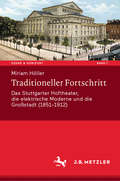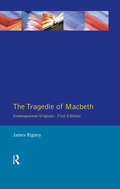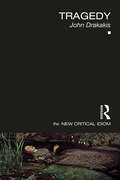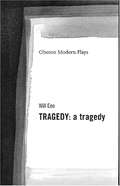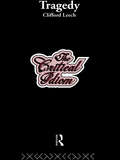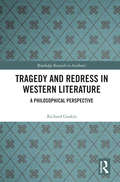- Table View
- List View
Towards an Ecocritical Theatre: Playing the Anthropocene (Routledge Environmental Humanities)
by Mohebat AhmadiTowards an Ecocritical Theatre investigates contemporary theatre through the lens of Anthropocene-oriented ecocriticism. It assesses how Anthropocene thinking engages different modes of theatrical representation, as well as how the theatrical apparatus can rise to the representational challenges of changing interactions between humans and the nonhuman world. To explore these problems, the book investigates international Anglophone plays and performances by Caryl Churchill, Stephen Sewell, Andrew Bovell, E.M. Lewis, Chantal Bilodeau, Jordan Hall, and Miwa Matreyek, who have taken significant steps towards re-orienting theatre from its traditional focus on humans to an ecocritical attention to nonhumans and the environment in the Anthropocene. Their theatrical works show how an engagement with the problem of scale disrupts the humanist bias of theatre, provoking new modes of theatrical inquiry that envision a scale beyond the human and realign our ecological culture, art, and intimacy with geological time. Moreover, the plays and performances studied here, through their liveness, immediacy, physicality, and communality, examine such scalar shifts via the problem of agency in order to give expression to the stories of nonhuman actants. These theatrical works provoke reflections on the flourishing of multispecies responsibilities and sensitivities in aesthetic and ethical terms, providing a platform for research in the environmental humanities through imaginative conversations on the world’s iterative performativity in which all bodies, human and nonhuman, are cast horizontally as agential forces on the theatrical world stage. This book will be of great interest to students and scholars of theatre studies, environmental humanities, and ecocritical studies.
Towards Embodied Performance: Directing and the Art of Composition
by Rachel DicksteinTowards Embodied Performance invites directors and other generative performance makers to experiment with making their own original, visually stunning, sonically immersive, and physically rigorous embodied performance.Through historical context, the author’s 30-plus years of experience, and original interviews with leading theatre artists, this book sets the stage for a new generation of artists building boundary-breaking work. Directors are often categorized into one of only two frameworks: the Stanislavskian director, whose method is based on text analysis and character wants and needs, and the “auteur” director, whose work might focus on visual spectacle at the expense of text or character objectives. This book argues that the director of embodied performance fuses these two approaches, acting as the author of the event. In Part I, readers will explore the core elements of embodied performance – space, time, body, language, and action – through a lens that bridges traditional directing methodology with experimental, devised, collaborative theatre-making. Part II provides examples of this embodied practice by multi-disciplinary artists in visual and sound installation, video and film, dance-theatre, and new music/opera, including such artists as Shirin Neshat, James Turrell, Bill T. Jones, Janet Cardiff, Okwui Okpokwasili, William Kentridge, and Heather Christian. Part III suggests creative prompts and exercises for performance makers to engage the visual, physical, textual, and sonic in compositional storytelling on stage.Towards Embodied Performance is an invaluable resource for theatre directors, devisers, and generative artists at all levels from students to teachers, from early-career to mid-career artists. Directors, actors, choreographers, designers, composers, writers, scholars, and engaged audience members can all use this text to explore collaboratively created performance that invites its audience into the ripest version of the present moment.
Towards Embodied Performance: Directing and the Art of Composition
by Rachel DicksteinTowards Embodied Performance invites directors and other generative performance makers to experiment with making their own original, visually stunning, sonically immersive, and physically rigorous embodied performance.Through historical context, the author’s 30-plus years of experience, and original interviews with leading theatre artists, this book sets the stage for a new generation of artists building boundary-breaking work. Directors are often categorized into one of only two frameworks: the Stanislavskian director, whose method is based on text analysis and character wants and needs, and the “auteur” director, whose work might focus on visual spectacle at the expense of text or character objectives. This book argues that the director of embodied performance fuses these two approaches, acting as the author of the event. In Part I, readers will explore the core elements of embodied performance – space, time, body, language, and action – through a lens that bridges traditional directing methodology with experimental, devised, collaborative theatre-making. Part II provides examples of this embodied practice by multi-disciplinary artists in visual and sound installation, video and film, dance-theatre, and new music/opera, including such artists as Shirin Neshat, James Turrell, Bill T. Jones, Janet Cardiff, Okwui Okpokwasili, William Kentridge, and Heather Christian. Part III suggests creative prompts and exercises for performance makers to engage the visual, physical, textual, and sonic in compositional storytelling on stage.Towards Embodied Performance is an invaluable resource for theatre directors, devisers, and generative artists at all levels from students to teachers, from early-career to mid-career artists. Directors, actors, choreographers, designers, composers, writers, scholars, and engaged audience members can all use this text to explore collaboratively created performance that invites its audience into the ripest version of the present moment.
Towards Good Lighting for the Stage: Aesthetic Theory for Theatrical Lighting Design
by Marcus DoshiTowards Good Lighting for the Stage: Aesthetic Theory for Theatrical Lighting Design explores the theoretical underpinnings of effective lighting design from conceptualization to live performance. Through an investigation of the author’s own aesthetic point of view—grounded in a broad investigation of art and design that blends pop culture and fine art, theory, and practice—this book documents the author’s thinking on the design process to fill the unexplored gap between an aesthetic philosophy and its expression in composition. Redefinitions of the artist, artwork, and spectator link beauty and artistic efficacy to arrive at a set of principles for assessment that demand that contemporary lighting design surpass utilitarian visibility to become a vital part of the total artwork that is a theatrical production. Inspired by the movements of the broader art and design worlds of the mid-19th century through present day—citing influences as diverse as Jennifer Tipton, Lois Tyson, Dieter Rams, and Dave Hickey—this book charts a course from the artistic team’s dramaturgical work to a solo studio concept to the tech table. Engaging and wide-ranging, Towards Good Lighting for the Stage synthesizes years of cross-disciplinary research and case studies of the author’s own work into provocative reading for practitioners of lighting design, advanced students, and academics, as well as those interested in connecting theatrical practice, aesthetic theory, and visual art.
Towards Good Lighting for the Stage: Aesthetic Theory for Theatrical Lighting Design
by Marcus DoshiTowards Good Lighting for the Stage: Aesthetic Theory for Theatrical Lighting Design explores the theoretical underpinnings of effective lighting design from conceptualization to live performance. Through an investigation of the author’s own aesthetic point of view—grounded in a broad investigation of art and design that blends pop culture and fine art, theory, and practice—this book documents the author’s thinking on the design process to fill the unexplored gap between an aesthetic philosophy and its expression in composition. Redefinitions of the artist, artwork, and spectator link beauty and artistic efficacy to arrive at a set of principles for assessment that demand that contemporary lighting design surpass utilitarian visibility to become a vital part of the total artwork that is a theatrical production. Inspired by the movements of the broader art and design worlds of the mid-19th century through present day—citing influences as diverse as Jennifer Tipton, Lois Tyson, Dieter Rams, and Dave Hickey—this book charts a course from the artistic team’s dramaturgical work to a solo studio concept to the tech table. Engaging and wide-ranging, Towards Good Lighting for the Stage synthesizes years of cross-disciplinary research and case studies of the author’s own work into provocative reading for practitioners of lighting design, advanced students, and academics, as well as those interested in connecting theatrical practice, aesthetic theory, and visual art.
'Town' and 'Honest' (Modern Plays)
by Dc Moore"So here I am, homeless at home and half-gratified to feel that I can be happy anywhere" John ClareInspired by the four-day journey made on foot by the legendary mad poet, John Clare, Town creates a new story set in contemporary Northampton. On John's return to Northampton from the bright lights of London, he finds his hometown is exactly the same as when he left it - from the rooms at his parent's house, to the Saturday nights on Abington Street. In fact, the only thing that seems to have changed... is John. Slipping back into his old habits, old jobs and old relationships, an out of work and disillusioned John considers why he swapped the anonymity of corporate city life for the comforts of home and embarked upon a sixty mile walk North.Northampton writer DC Moore's Town poignantly explores enduring themes of identity, isolation and belonging, rooting them in modern life. With heartbreaking honesty and humour, the play probes the feelings that we all have about our hometown, and follows one man on his road to get back to where he started. This edition also includes the darkly comic monologue Honest, where one man's addiction for telling the truth leads to a night that spirals out of control. Taking you on a journey across London towards a late-night epiphany, the piece explores the lies we tell ourselves and each other, and the fall-out when the truth is revealed.
Town' and 'Honest' (Modern Plays)
by DC Moore"So here I am, homeless at home and half-gratified to feel that I can be happy anywhere" John ClareInspired by the four-day journey made on foot by the legendary mad poet, John Clare, Town creates a new story set in contemporary Northampton. On John's return to Northampton from the bright lights of London, he finds his hometown is exactly the same as when he left it - from the rooms at his parent's house, to the Saturday nights on Abington Street. In fact, the only thing that seems to have changed... is John. Slipping back into his old habits, old jobs and old relationships, an out of work and disillusioned John considers why he swapped the anonymity of corporate city life for the comforts of home and embarked upon a sixty mile walk North.Northampton writer DC Moore's Town poignantly explores enduring themes of identity, isolation and belonging, rooting them in modern life. With heartbreaking honesty and humour, the play probes the feelings that we all have about our hometown, and follows one man on his road to get back to where he started. This edition also includes the darkly comic monologue Honest, where one man's addiction for telling the truth leads to a night that spirals out of control. Taking you on a journey across London towards a late-night epiphany, the piece explores the lies we tell ourselves and each other, and the fall-out when the truth is revealed.
Town Is Dead (Oberon Modern Plays)
by Phillip McMahonEllen thought she’d end her life where it began – in a rundown flat in Dublin’s north inner city. Now her building is sold, and she’s being moved into a box room in her snooty sister’s house in the suburbs. When an unexpected visitor lands in her front room, Ellen is forced to delve into the past in order to lay some ghosts to rest. Town is Dead is an ode to Dublin and an exploration of how Ireland treats its people. It looks at the future of the city through the eyes of one older citizen.
Townsend Plays: Secret Diary of Adrian Mole; Womberang; Bazaar and Rummage; Groping for Words; Great Celestial Cow (Contemporary Dramatists)
by Sue TownsendA play by one of Britain's best-selling writersBazaar and Rummage brings together a neurotic do-gooder, a trainee social worker and three agoraphobics who have been persuaded to venture out of their homes to run a jumble sale. "As a study of agoraphobia, Bazaar and Rummage...is written with great verve, style and wit." (Benedict Nightingale); Set in an adult literacy class where the student's fear of ignorance is as much of a handicap as their inability to read, Groping for Words is a "close up of the social scrap-heap, written in a fine vein of comic indignation and giving a voice to people whose lives are mainly spent in queues and waiting rooms." (Irving Wardle, The Times); Womberang shows free spirit Rita Onions bringing joy and anarchy to the grim waiting-room of a gynaecology clinic. "A daydream of mastered fear" (New Society)
Townsend Plays: Secret Diary of Adrian Mole; Womberang; Bazaar and Rummage; Groping for Words; Great Celestial Cow (Contemporary Dramatists)
by Sue TownsendA play by one of Britain's best-selling writersBazaar and Rummage brings together a neurotic do-gooder, a trainee social worker and three agoraphobics who have been persuaded to venture out of their homes to run a jumble sale. "As a study of agoraphobia, Bazaar and Rummage...is written with great verve, style and wit." (Benedict Nightingale); Set in an adult literacy class where the student's fear of ignorance is as much of a handicap as their inability to read, Groping for Words is a "close up of the social scrap-heap, written in a fine vein of comic indignation and giving a voice to people whose lives are mainly spent in queues and waiting rooms." (Irving Wardle, The Times); Womberang shows free spirit Rita Onions bringing joy and anarchy to the grim waiting-room of a gynaecology clinic. "A daydream of mastered fear" (New Society)
Trad (Oberon Modern Plays Ser.)
by Mark DohertyA fable about tradition in a mad place, Trad is the hilarious tale of the very old Thomas and his even more ancient ‘da’. When Thomas reveals that he once fathered a son in a long-ago fling, the pair set off across the Irish countryside to seek the unknown child, with nothing more than a hobble and a limp to help them. A surreal comedy from former comedian Mark Doherty, and a five-star hit at the 2005 Edinburgh Festival, Trad presents a deeply funny journey of discovery, fuelled by a past that’s just as bizarre as the present. Trad opened at the Bush Theatre, London in April 2006.
Tradition & Change Performance (Musical Performance Ser. #Vols. 2, Pts. 2.)
by TsaoFirst published in 1998. Routledge is an imprint of Taylor & Francis, an informa company.
Tradition & Change Performance
by TsaoFirst published in 1998. Routledge is an imprint of Taylor & Francis, an informa company.
The Tradition of the Actor-author in Italian Theatre
by Donatella Fischer"The central importance of the actor-author is a distinctive feature of Italian theatrical life, in all its eclectic range of regional cultures and artistic traditions. The fascination of the figure is that he or she stands on both sides of one of theatre's most important power relationships: between the exhilarating freedom of performance and the austere restriction of authorship and the written text. This broad-ranging volume brings together critical essays on the role of the actor-author, spanning the period from the Renaissance to the present. Starting with Castiglione, Ruzante and the commedia dell'arte, and surveying the works of Dario Fo, De Filippo and Bene, among others, the contributors cast light on a tradition which continues into Neapolitan and Sicilian theatre today, and in Italy's currently fashionable 'narrative theatre', where the actor-author is centre stage in a solo performance."
The Tradition of the Actor-author in Italian Theatre
by Donatella Fischer"The central importance of the actor-author is a distinctive feature of Italian theatrical life, in all its eclectic range of regional cultures and artistic traditions. The fascination of the figure is that he or she stands on both sides of one of theatre's most important power relationships: between the exhilarating freedom of performance and the austere restriction of authorship and the written text. This broad-ranging volume brings together critical essays on the role of the actor-author, spanning the period from the Renaissance to the present. Starting with Castiglione, Ruzante and the commedia dell'arte, and surveying the works of Dario Fo, De Filippo and Bene, among others, the contributors cast light on a tradition which continues into Neapolitan and Sicilian theatre today, and in Italy's currently fashionable 'narrative theatre', where the actor-author is centre stage in a solo performance."
Traditioneller Fortschritt: Das Stuttgarter Hoftheater, die elektrische Moderne und die Großstadt (1851-1912) (Szene & Horizont. Theaterwissenschaftliche Studien #7)
by Miriam HöllerDie Studie über das Stuttgarter Hoftheater denkt Theater und Stadt zur Zeit der Elektrifizierung um 1900 zusammen. Welchen Einfluss hatte die Theatertechnik auf die werdende Großstadt? Wie wurde umgekehrt das Theater durch die Urbanisierung und Technisierung der Stadt geprägt? Die Studie untersucht anhand historischer Quellen diese Wechselbeziehung über die Analyse neuer räumlich-materieller Vernetzungen. Außerdem analysiert sie kollektive Großstadt-Imaginationen, die zwischen 1902 und 1912 bei der Planung eines Theaterneubaus in Stuttgart aufkamen und die insbesondere über die Architektur und Technik des Theaters verhandelt wurden. Zentral war dabei eine Aushandlung im Spannungsfeld von Tradition und Moderne. So zeigt die Studie, dass auch ein Hoftheater fern der Metropolen als Ort der Moderne erfahren werden konnte, und leistet somit am Schnittpunkt von Theater-, Technik-, Stadt- und Kulturgeschichte einen Beitrag zur Erforschung der Vielfalt des deutschen Theaters um 1900.
The Tragedie of Macbeth: The Folio of 1623
by James RigneyThe Shakespearean Originals Series takes as its point of departure the question: "What is it that we read Shakespeare?" The answer may seem self-evident: we read the words that Shakespeare wrote. But do we? In the case of all the major editions of Shakespeare available in the market, the fact of the matter is that many of the words that we read in an edition of, say, Hamlet, never appeared in the text as it was printed during or shortly after Shakespeare's own lifetime. They are the interpetations and interpolations of a series of editors who have been systematically changing Shakespeare's text from the eighteenth century onwards. This volume offers the text of Macbeth, as printed in the 1623 First Folio.
The Tragedie of Macbeth: The Folio of 1623 (Timeless Shakespeare)
by James RigneyThe Shakespearean Originals Series takes as its point of departure the question: "What is it that we read Shakespeare?" The answer may seem self-evident: we read the words that Shakespeare wrote. But do we? In the case of all the major editions of Shakespeare available in the market, the fact of the matter is that many of the words that we read in an edition of, say, Hamlet, never appeared in the text as it was printed during or shortly after Shakespeare's own lifetime. They are the interpetations and interpolations of a series of editors who have been systematically changing Shakespeare's text from the eighteenth century onwards. This volume offers the text of Macbeth, as printed in the 1623 First Folio.
Tragedy (The New Critical Idiom)
by John DrakakisTragedy is one of the oldest and most resilient forms of narrative. Considering texts from ancient Greece to the present day, this comprehensive introduction shows how tragedy has been re-imagined and redefined throughout Western cultural history. Tragedy offers a concise history of tragedy tracing its evolution through key plays, prose, poetry and philosophical dimensions. John Drakakis examines a wealth of popular plays, including works from the ancient Greeks, Shakespeare, Bertolt Brecht, Sarah Kane and Tom Stoppard. He also considers the rewriting and appropriating of ancient drama though a wide range of authors, such as Chaucer, George Eliot, Ted Hughes and Colm Tóibín. Drakakis also demystifies complex philosophical interpretations of tragedy, including those of Hegel, Kierkegaard, Nietzsche and Benjamin. This accessible resource is an invaluable guide for anyone studying tragedy in literature or theatre studies.
Tragedy (The New Critical Idiom)
by John DrakakisTragedy is one of the oldest and most resilient forms of narrative. Considering texts from ancient Greece to the present day, this comprehensive introduction shows how tragedy has been re-imagined and redefined throughout Western cultural history. Tragedy offers a concise history of tragedy tracing its evolution through key plays, prose, poetry and philosophical dimensions. John Drakakis examines a wealth of popular plays, including works from the ancient Greeks, Shakespeare, Bertolt Brecht, Sarah Kane and Tom Stoppard. He also considers the rewriting and appropriating of ancient drama though a wide range of authors, such as Chaucer, George Eliot, Ted Hughes and Colm Tóibín. Drakakis also demystifies complex philosophical interpretations of tragedy, including those of Hegel, Kierkegaard, Nietzsche and Benjamin. This accessible resource is an invaluable guide for anyone studying tragedy in literature or theatre studies.
Tragedy: A Tragedy (Oberon Modern Plays Ser.)
by Will EnoThe sun has set over streets of houses, government buildings and American backyards everywhere. The world is dark. A news team is on the scene. Their report: someone left the lawn sprinklers on; someone’s horse is loose; a seashell is lying in the grass; dogs run by. The Governor issues excited statements appealing for calm. It is night-time in the world. Everyone’s afraid. Everyone doesn’t know if the sun, once down, will ever rise again. But there is a witness, and the witness will speak.
Tragedy
by Clifford LeechProfessor Leech considers the significance of the term ‘Tragedy’ as it has been used from classical times to the present day. He gives examples of tragic writing from a wide variety of dramatic literatures and relates theoretical writings on tragedy and the tragedies that have been contemporaneous with them. Free reference is made to critics from Aristotle to these of the present. Special stress is laid on the tragedies of the Greeks, of Renaissance writers and of our immediate contemporaries, notably Harold Pinter and Tom Stoppard. There is also discussion of tragic writing in the modern novel.
Tragedy (The\critical Idiom Reissued Ser. #1)
by Clifford LeechProfessor Leech considers the significance of the term ‘Tragedy’ as it has been used from classical times to the present day. He gives examples of tragic writing from a wide variety of dramatic literatures and relates theoretical writings on tragedy and the tragedies that have been contemporaneous with them. Free reference is made to critics from Aristotle to these of the present. Special stress is laid on the tragedies of the Greeks, of Renaissance writers and of our immediate contemporaries, notably Harold Pinter and Tom Stoppard. There is also discussion of tragic writing in the modern novel.
Tragedy and Redress in Western Literature: A Philosophical Perspective (Routledge Research in Aesthetics)
by Richard GaskinThis book offers a unique interpretation of tragic literature in the Western tradition, deploying the method and style of Analytic philosophy. Richard Gaskin argues that tragic literature seeks to offer moral and linguistic redress (compensation) for suffering. Moral redress involves the balancing of a protagonist’s suffering with guilt (and vice versa): Gaskin contends that, to a much greater extent than has been recognized by recent critics, traditional tragedy represents suffering as incurred by avoidable and culpable mistakes of a cognitive nature. Moral redress operates in the first instance at the level of the individual agent. Linguistic redress, by contrast, operates at a higher level of generality, namely at the level of the community: its fundamental motor is the sheer expressibility of suffering in words. Against many writers on tragedy, Gaskin argues that language is competent to express pain and suffering, and that tragic literature has that expression as one its principal purposes. The definition of tragic literature in this book is expanded to include more than stage drama: the treatment stretches from the Classical and Medieval periods through to the early twentieth century. There is a special focus on Sophocles, but Gaskin takes account of most other major tragic authors in the European tradition, including Homer, Aeschylus, Euripides, Virgil, Seneca, Chaucer, Marlowe, Shakespeare, Corneille, Racine, Lessing, Goethe, Schiller, Kleist, Büchner, Ibsen, Hardy, Kafka, and Mann; lesser-known areas, such as Renaissance neo-Latin tragedy, are also covered. Among theorists of tragedy, Gaskin concentrates on Aristotle and Bradley; but the contributions of numerous contemporary commentators are also assessed. Tragedy and Redress in Western Literature: A Philosophical Perspective offers a new and genuinely interdisciplinary perspective on tragedy that will be of considerable interest both to philosophers of literature and to literary critics.
Tragedy and Redress in Western Literature: A Philosophical Perspective (Routledge Research in Aesthetics)
by Richard GaskinThis book offers a unique interpretation of tragic literature in the Western tradition, deploying the method and style of Analytic philosophy. Richard Gaskin argues that tragic literature seeks to offer moral and linguistic redress (compensation) for suffering. Moral redress involves the balancing of a protagonist’s suffering with guilt (and vice versa): Gaskin contends that, to a much greater extent than has been recognized by recent critics, traditional tragedy represents suffering as incurred by avoidable and culpable mistakes of a cognitive nature. Moral redress operates in the first instance at the level of the individual agent. Linguistic redress, by contrast, operates at a higher level of generality, namely at the level of the community: its fundamental motor is the sheer expressibility of suffering in words. Against many writers on tragedy, Gaskin argues that language is competent to express pain and suffering, and that tragic literature has that expression as one its principal purposes. The definition of tragic literature in this book is expanded to include more than stage drama: the treatment stretches from the Classical and Medieval periods through to the early twentieth century. There is a special focus on Sophocles, but Gaskin takes account of most other major tragic authors in the European tradition, including Homer, Aeschylus, Euripides, Virgil, Seneca, Chaucer, Marlowe, Shakespeare, Corneille, Racine, Lessing, Goethe, Schiller, Kleist, Büchner, Ibsen, Hardy, Kafka, and Mann; lesser-known areas, such as Renaissance neo-Latin tragedy, are also covered. Among theorists of tragedy, Gaskin concentrates on Aristotle and Bradley; but the contributions of numerous contemporary commentators are also assessed. Tragedy and Redress in Western Literature: A Philosophical Perspective offers a new and genuinely interdisciplinary perspective on tragedy that will be of considerable interest both to philosophers of literature and to literary critics.
